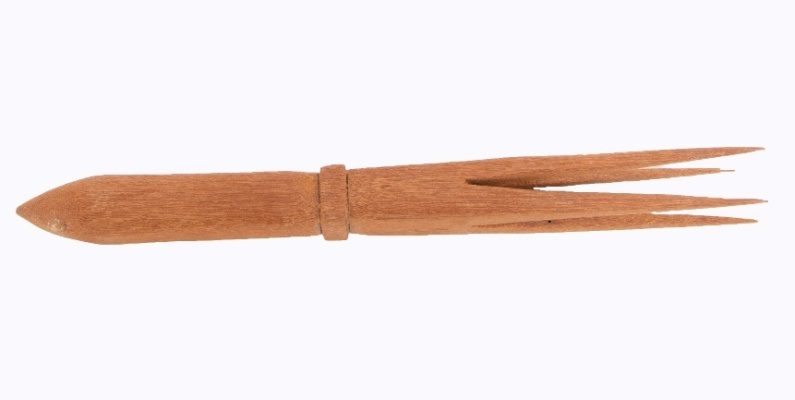
Did you read that right? Cannibal fork? As in a fork for eating people?
Correct! This beautifully carved four-pronged wooden object is called a cannibal fork, or a flesh fork. During an inventory project in our Melanesian Collection, I came across a box labelled ‘Cannibal Forks’. I was confused, and intrigued, by this label. Were these forks that ate forks? (So funny). Or were these in fact specialised cutlery for eating people?
I had to know the answer to these questions, and so I delved into the deep recesses of the internet to find my answers, and find them I did!
Cannibal forks originate from Fiji and were called ai cula ni bokola by the people there. Now cannibal forks are not used to eat just anyone’s flesh. They were an object of the ultimate taboo and were only used in rituals to feed chiefs.
When Abel Tasman, and later Captain Cook, first came to the Fiji, they found tribes who seemed to eat the flesh of their own for no other reason than hunger. This led to the islands being named the Cannibal Isles, and tales spread about the violent tribes who lived there.
However, further research of the tribes revealed a people who had mastered the art of agriculture and fishing, and therefore were very capable of feeding themselves. So, if the cannibal nature of the tribes was not a product of hunger, why did they eat each other?
The tribes of Fiji lived in almost constant warfare due to the lack of land on the islands and were constantly fighting for territory, space, and control. It was discovered that the cannibalism was a part of a ritual of humiliation and revenge. After a battle between two tribes, the victorious side would eat the flesh of the fallen tribe.
So where do these forks come in? Well, the chief of the tribe was deemed too holy to handle the flesh of the dead. Therefore, these forks were made to feed the meat to the chief. In this way the chief was able to partake in the ritual while staying spiritually clean and holy.
Because of the taboo nature of the cannibal forks, they were highly treasured and were kept in the spirit house, a temple of worship for the tribal community.
Unlike the one above, many cannibal forks were carved in a shape similar to the spears used by the tribes of Fiji. This may show a link between the warfare function of the spear, and the ritualistic humiliation of the fallen tribe using the fork.
Top Image: Four pronged, carved wooden instrument. Old Stock. D88.397.Otago Museum Collection.
